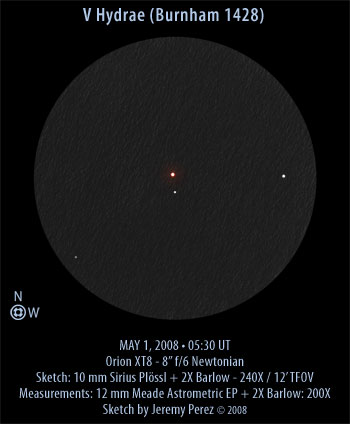
Click image for larger version
Observation Notes:
I unexpectedly ran across this beautiful double while tracking comet C/2007 W1 (Boattini). The rich, red carbon star primary jumped out at me and I couldn’t resist giving it a closer look. The primary was a rich, red–almost like seeing a ‘hot pixel’ burning in the eyepiece. The secondary is a K0 star, but I didn’t detect any color there. Measuring with the Astrometric eyepiece attached to the Dobsonian is a pain, but I came up with a PA of 185 degrees, and a separation of 47 degrees. CCDM (1991) values are 185.7 degrees and 46.8 arc seconds. I’m not sure how widely the carbon star varies in brightness, but since it appeared brighter than nearby 8th magnitude HIP 53050, it seemed to be 7th magnitude this evening. If you like carbon stars or colorful doubles, be sure to give this beauty a look!
Object Information
V Hydrae ranks up there with T Lyrae and Hind’s Crimson Star as the reddest stars in the sky with a B-V value of +5.5. It is a variable star, and has two overlapping cycles. The short term cycle varies by about 1.5 magnitudes over a period of 533 days so that it can often be found cycling from 7 to 8.5 magnitude. The second cycle introduces a deep minima every 6500 days that can drop the star’s brightness to 12th magnitude (Journal of the Royal Astronomical Society of Canada, Vol. 59, p.245-6). It appears that this star, at the end of its life, is just now ejecting high speed jets that will soon form a planetary nebula. Because this process is so short-lived, V Hydrae offers a unique opportunity for astronomers to gather data on the early phases of the formation of a planetary nebula. Further information about these findings can be seen here.
| Subject | V Hydrae (BU 1428) |
| Classification | Multiple Star, Variable Star, Carbon Star |
| Position (J2000) | Hydra [RA: 10:51:37.2 / Dec: -21:15:00]* |
| Position Angle* | 185° [2008.3 my measurement] 185.7° [1991 CCDM] |
| Separation* | 47″ [2008.3 my measurement] 46.8″ [1991 CCDM] |
| Magnitudes* | 7.5 / 11.5 |
| Spectral Types* | C6.5 / K0III |
| Date/Time | APR 30, 2008 – 10:30 PM MST (MAY 1, 2008 – 06:30 UT) |
| Observing Loc. | Flagstaff, AZ – Home |
| Instrument | Orion XT8 (203 mm dia./1200 mm F/L) |
| Eyepieces/Mag. | 10 mm Sirius Plössl + 2X Barlow (240X) 12 mm Meade Astrometric EP + 2X Barlow (200X) |
| Conditions | Clear, gusty winds |
| Seeing | 4/10 Pickering |
| Transparency | NELM Mag ~4.0 |
| *References | The Washington Visual Double Star Catalog, 1996.0 (Worley+, 1996); CCDM (Catalog of Components of Double & Multiple stars (Dommanget+ 2002); Catalogue of Stellar Spectral Classifications (Skiff, 2007); Starry Night Pro Plus 5.8 |
I enjoyed your entry here, and your beautiful drawing — more than a ‘sketch’!
This evening I looked at V Hya; since I live in a very light-polluted area, I had to hop my way all the way from Alphard, way to the west. But I did find it, and like you, I was knocked out by its redness.
My telescope is the same one you used (Orion 8-inch dob), but I didn’t crank the magnification high enough to resolve the companion. Still, the star is a beauty!
Hi Steve,
It sure is a stunning sight. I was pretty amazed to see it by accident while observing Comet Boattini. Thanks for the comment!
Jeremy